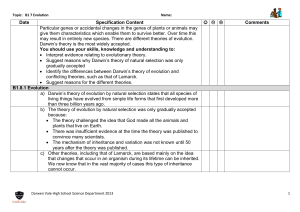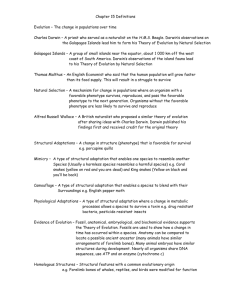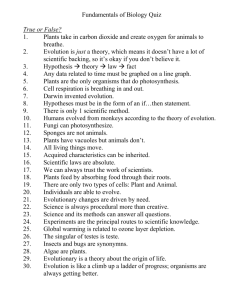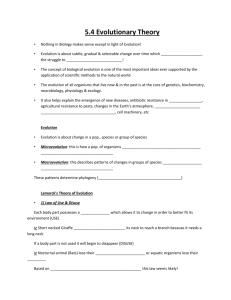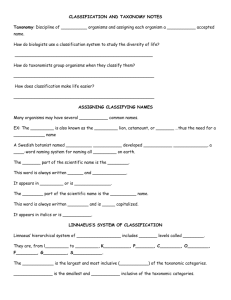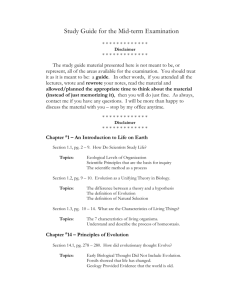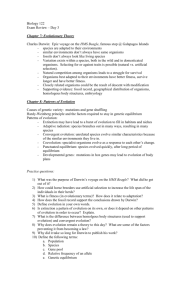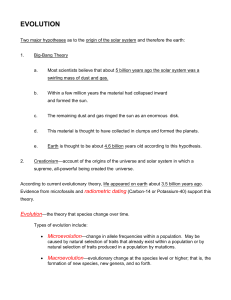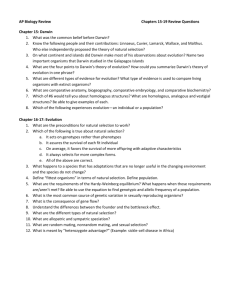Development of the Concept of Evolution
advertisement
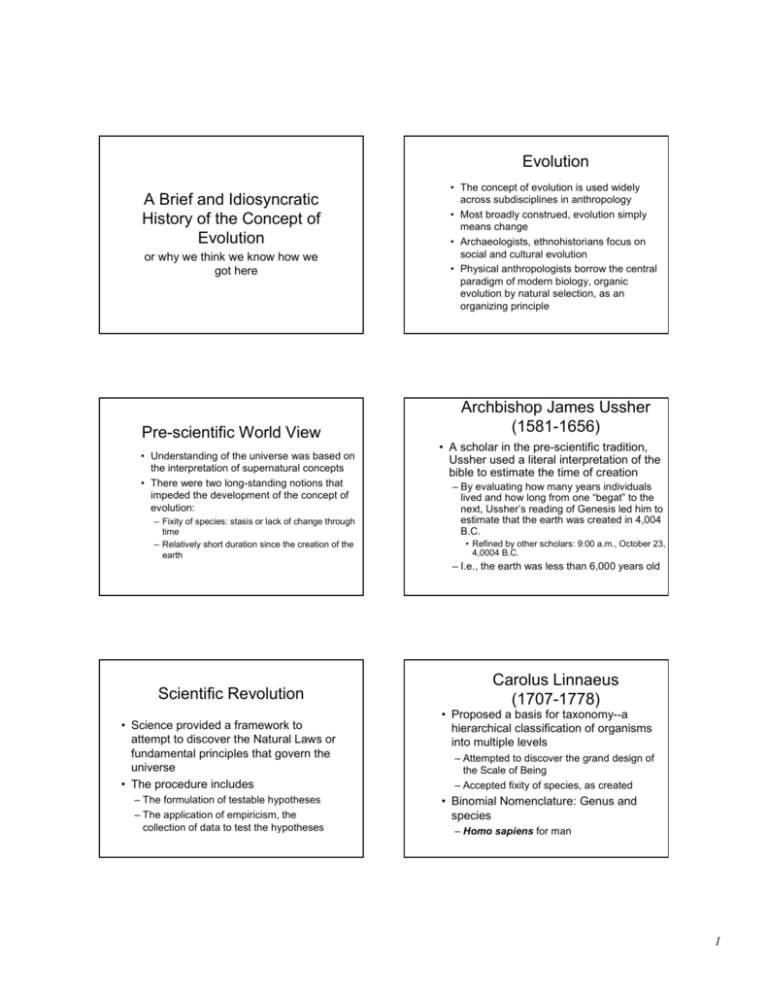
Evolution A Brief and Idiosyncratic History of the Concept of Evolution or why we think we know how we got here Pre-scientific World View •Understanding of the universe was based on the interpretation of supernatural concepts •There were two long-standing notions that impeded the development of the concept of evolution: –Fixity of species: stasis or lack of change through time –Relatively short duration since the creation of the earth •The concept of evolution is used widely across subdisciplines in anthropology •Most broadly construed, evolution simply means change •Archaeologists, ethnohistorians focus on social and cultural evolution •Physical anthropologists borrow the central paradigm of modern biology, organic evolution by natural selection, as an organizing principle Archbishop James Ussher (1581-1656) •A scholar in the pre-scientific tradition, Ussher used a literal interpretation of the bible to estimate the time of creation –By evaluating how many years individuals l i vedandhowl ongf r om one“ begat ”t ot he nex t ,Ussher ’ sr eadi ngofGenesi sl edhi mt o estimate that the earth was created in 4,004 B.C. •Refined by other scholars: 9:00 a.m., October 23, 4,0004 B.C. –I.e., the earth was less than 6,000 years old Scientific Revolution •Science provided a framework to attempt to discover the Natural Laws or fundamental principles that govern the universe •The procedure includes –The formulation of testable hypotheses –The application of empiricism, the collection of data to test the hypotheses Carolus Linnaeus (1707-1778) •Proposed a basis for taxonomy--a hierarchical classification of organisms into multiple levels –Attempted to discover the grand design of the Scale of Being –Accepted fixity of species, as created •Binomial Nomenclature: Genus and species –Homo sapiens for man 1 Jean Baptiste Lamarck (1744 - 1829) •Evolution of species according to fixed laws –Species adapt to changing environment by use/disuse of organs –Systems develop according to wants & needs of organism •e.g., fish in drying lake develop lungs as needed for oxygen –Proposed mechanism: Inheritance of acquired characteristics Charles Lyell (1797 - 1875) •Uniformitarianism –Geological processes same in past as they are today –Slow, gradual process of earth's formation –Earth vastly older than estimated by clerics Charles Darwin (1809-1882) •During the 5 year cruise of the Beagle, Dar wi ncol l ect edspeci mens,r eadLy el l ’ s Principles of Geology, and became convinced of the transmutability of species •After returning home, a reading of Malthus finally triggered the notion of natural selection as the mechanism driving evolution Georges Cuvier (1769-1832) •Pope of Bones--Father of Paleontology •Believed in the fixity of species •Proposed Catastrophism from natural causes as a mechanism to produce fossils Thomas Malthus (1766-1834) •English clergyman and economist •An Essay on the Principle of Population (1798): –Population growth potentially exceeds increases in food resources –In nature, overpopulation is checked by a struggle for existence between members of a species –Not all organisms secure adequate food every generation –Most individuals die, leaving only a few who survive to perpetuate the species Alfred Russel Wallace (1823-1913) •Came to the same conclusions about evolution by natural selection as a result of his work in the Malayan Archipelago •Wallace became a fervent selectionist, ending up not believing in human evolution because he could not envision the adaptive purpose for the human mind 2 Thomas Huxley (1825 - 1895) Principles of Natural Selection •Acquainted with both Darwin and Wallace •Uponr eadi ngDar wi n’ sOn the Origin of Species... i sr epor t edt ohaves ai d,“ How obvious. How stupid of me not to have t houghtofi tmys el f . ” •Became“ Dar wi n’ sBul l dog, ”t hef i er c e proponent of evolution by natural selection in the public forum •Offspring produced faster than food supply increases •All living organisms vary (especially to be noted between members of the same species) •Because more individuals are born than survive, there is a struggle for existence •Those individuals with favorable adaptations are most likely to survive and leave offspring, sometimes known as survival of the fittest Principles of Natural Selection Principles of Natural Selection •The environment determines which traits are beneficial and which are not •As a result, individuals with favorable adaptations increase in relative number from generation to generation –Traits that are favorable in one setting may be harmful in another –Greater and greater numbers and proportions within the species have the adaptation •Traits are inherited and passed on in a relatively stable way to the next generation •Over long periods of time, such successful variations (favorable adaptations) produce differences that result in the formation of new species –That is, offspring tend to resemble their parents and reflect the variations possessed by their parents Darwinian Evolution Darwin's Evidence Species A Environmental Change Species B RE P RO DU CT IV EI SO L AT IO N •The way that changes are bred into domesticated organisms, especially pigeons •Geographic distribution of species such as the finches of the Galapagos Islands •The geological and paleontological record •Comparative anatomy (e.g., the resemblance between apes and man) •Embryology (e.g., the possession of gills by mammalian embryos) Species A 3 Darwin's Failures •Never understood the source of the variation that is so important for the operation of natural selection –Mutation •Never understood the nature of inheritance, in spite of having a reprint ofMendel ’ s1865publ i cat i on “ Not hi ngi nbi ol ogymakes sense except in the light of ev ol ut i on” Theodosius Dobzhansky –Particulate Inheritance Simultaneous Rediscovery of Mendel (1900) “ Theal t er nat i v et ot hi nki ngi n evolutionary terms is not to t hi nkatal l ” •Hugo de Vries, Holland •Erich von Tschermak, Austria •Carl Correns, Germany Sir Peter Medawar Basis of population genetics-equilibrium model •William E. Castle, 1903, American animal breeder •Godfrey H. Hardy, 1908, British mathematician •Wilhelm Weinberg, 1908, German physician Development of Population Genetics from H-W Model •R.A. Fisher, 1930, The Genetical Theory of Natural Selection •J.B.S. Haldane, 1932, The Causes of Evolution •Sewall Wright, 1931, Evolution in Mendelian Populations 4 Synthesis of genetics and Darwinism •Theodosius Dobzhansky, 1937, Genetics and the Origin of Species •Julian S. Huxley, 1942, Evolution. The Modern Synthesis •Ernst Mayr, 1942, Systematics and the Origin of Species Biological Species Concept •Shortcomings of concept: –Restricted to sexually reproducing organisms, so does not apply to single cell organisms that reproduce by simple cell division (mitosis) –No clear application to the fossil record, since reproductive isolation does not show up in fossilized materials Biological Species Concept •Species are groups of interbreeding natural populations that are reproductively isolated from other such groups (Mayr, 1963) –Defines species in terms of the gene pool, isolated from other similar gene pools Paleospecies •A paleospecies or chronospecies is a morphologically or anatomically defined fossil species –Since interbreeding is not determinable for extinct species, species boundaries are determined by similarity of form •Still most useful concept to understand the evolution of species Speciation •The process by which new species are produced from earlier ones. This is the central process of macroevolution, or evolution at the level of the species or above –Microevolution involves evolutionary change at the level of the population, and is defined by changes in allele frequencies within the population Origin of Species •Speciation occurs when populations of a species become reproductively isolated so that they can no longer interbreed with full fertility –Geographic isolation of populations usually initiates the process –Selection operates to produce isolating mechanisms of anatomy, behavior, etc. 5 Modes of Evolution •Cladogenesis is branching evolution, the production of two or more daughter species from a single ancestral species •Anagenesis is linear evolution, the production of a single daughter species from a single ancestral species Tempo of Evolution •Gradualism views evolutionary change as occurring at a slow, steady rate over time •Punctuated Equilibrium views the tempo of evolution as consisting of long periods of stability (equilibrium), followed by relatively short periods of rapid evolutionary change (punctuations) Tempo of Evolution a. Gradual change through time b. Increasing rate of change through time c. Punctuated equilibrium: stasis and bursts of change 6
